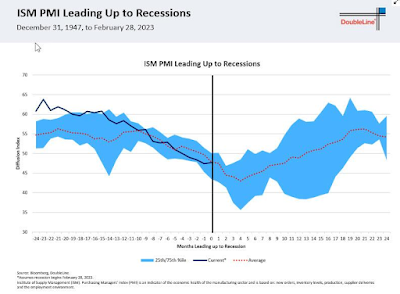*** denotes well-worth reading in full at source (even if excerpted extensively here)
Economic and Market Fare:
The spread between BBB rated dollar-denominated corporate debt and the earnings available on the S&P 500 Index of stocks is now above zero for the first time since the global financial crisis. The average yield on investment-grade bonds is 5.77%, compared with an estimated earnings yield of 5.42% on the S&P
The differential is typically negative, reflecting the higher risk of capital that is invested in equities even as corporate bond yields stay elevated. However, when speculative money flocks into equities, it turns positive, suggesting that investors may be overlooking the risk embedded in stocks.
The spread turned positive during the days of the dot-com boom, peaking at about 470 basis points before the bubble burst. It again turned positive in the run-up to the financial crisis, reaching almost 215 basis points. Neither of those movies ended well.
.... This first thing to say is that the US economy certainly didn’t add 517,000 jobs in January. January is a month where millions of people lose their jobs. ......
Sellers’ Inflation, Profits, and Conflict: Why Can Large Firms Hike Prices in an Emergency?
- China’s economic development model resembles that of Japan over 30 years ago with high savings, and high investment, but with restrained consumption and rigid institutions weighing increasingly on macroeconomic success.
- China’s chronic over-investment and misallocation of capital, particularly in the property sector, pose a potentially bigger economic problem than Japan’s banking crisis in the 1990s.
- China has some advantages over Japan, such as a state-owned financial system that can prevent significant banks from failing and a closed capital account that can protect the country’s banking system and the economy from the risk of significant capital flight. This however might not prevent China from taking the same economic trajectory Japan has.
Bubble Fare:
Quotes of the Week:
UBS' Donovan: In the US today, a non-economist will attempt to explain to a collection of non-economists the extraordinary complexity of an economy undergoing dramatic structural change. The questioning will be mainly partisan point scoring. The question Fed Chair Powell needs to be asked is “what do you think you are doing?”. Powell has yet to explain how raising rates will tackle profit-led inflation. Pursuing higher unemployment seems an ineffective response…
Channeling Lacy @TheBondFreak notes ODL (other deposit liabilities=M2 -[currency+money market funds] spiked ‘20-21 driving inflation. Mar 22 ODL began falling &now -5% YoY. If velocity doesn’t rise, ODL down should=deflation “if” Lacy, Friedman & Fisher right. My guess, they are! pic.twitter.com/jCFwIHrjDF
— Danielle DiMartino Booth (@DiMartinoBooth) March 6, 2023
Construction employment has (so far) saved the economy from recession.
— Eric Basmajian (@EPBResearch) March 7, 2023
This thread explains why this happened, why it won’t last much longer, and how this extra lag increased the risk of a hard landing.
1/
Vid Fare:
couple of great quotes just from the first 3 minutes:
"he's gone from transitory to disingenuous"..."it is AMAZING to me the damage that central bankers are going to do"
...I don't have strong views about this week's jobs report because I don't have strong views about short-term noise.
— John P. Hussman, Ph.D. (@hussmanjp) March 6, 2023
A -0.3% drop in payrolls in the next 3 reports would be a total loss over 450K.
Keep in mind the worst SPX losses in 2000-02 and 2007-09 came AFTER the Fed pivot. pic.twitter.com/EVP2zpZTSG
...Here's a history of US home price appreciation going back to 1891. 2022 was the first down year for home prices on an inflation-adjusted basis since 2011. In 2023 we could see the first nominal declines since 2011. pic.twitter.com/kgDlj1pKT8
— Charlie Bilello (@charliebilello) March 4, 2023
*via NY Fed, Younger borrowers (20-49yrs) are seeing CC delinquencies surpass pre-pandemic lvls - and auto loan delinquencies are right behind it
— Adem Tumerkan (@RadicalAdem) March 7, 2023
The under 50’s group are beginning to feel the pain of higher costs, higher prices, anemic real wages
This will only get worse pic.twitter.com/HalX9RsV6t
...Spec positioning in US Treasuries just moved to a record short…
— Julien Bittel, CFA (@BittelJulien) March 4, 2023
The last time we were anywhere near these levels was back in October 2018.
Back then, 10-year yields peaked shortly after and over the next sixteen months, yields fell by 2.7%.
The bull case for bonds is growing. pic.twitter.com/xoINO0jwVn
2/ The S&P 500 broke above its macro downtrend line in Jan 2023
— Game of Trades (@GameofTrades_) March 7, 2023
Many investors are now calling for a resumption of the bull run
In this thread, we’ll go through every major bear market to understand whether this actually holds any value pic.twitter.com/4JOoIrVPQA
(not just) for the ESG crowd:























No comments:
Post a Comment